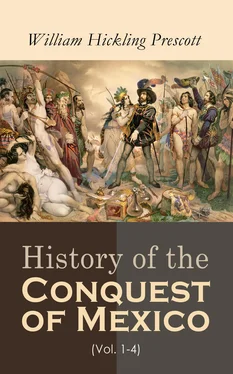I shall conclude the account of Mexican science with that of a remarkable festival, celebrated by the natives at the termination of the great cycle of fifty-two years. We have seen, in the preceding chapter, their tradition of the destruction of the world at four successive epochs. They looked forward confidently to another such catastrophe, to take place, like the preceding, at the close of a cycle, when the sun was to be effaced from the heavens, the human race from the earth, and when the darkness of chaos was to settle on the habitable globe. The cycle would end in the latter part of December, and as the dreary season of the winter solstice approached, and the diminished light of day gave melancholy presage of its speedy extinction, their apprehensions increased; and on the arrival of the five “unlucky” days which closed the year they abandoned themselves to despair. [206]They broke in pieces the little images of their household gods, in whom they no longer trusted. The holy fires were suffered to go out in the temples, and none were lighted in their own dwellings. Their furniture and domestic utensils were destroyed; their garments torn in pieces; and every thing was thrown into disorder, for the coming of the evil genii who were to descend on the desolate earth.
On the evening of the last day, a procession of priests, assuming the dress and ornaments of their gods, moved from the capital towards a lofty mountain, about two leagues distant. They carried with them a noble victim, the flower of their captives, and an apparatus for kindling the new fire , the success of which was an augury of the renewal of the cycle. On reaching the summit of the mountain, the procession paused till midnight; when, as the constellation of the Pleiades approached the zenith, [207]the new fire was kindled by the friction of the sticks placed on the wounded breast of the victim. [208]The flame was soon communicated to a funeral pile, on which the body of the slaughtered captive was thrown. As the light streamed up towards heaven, shouts of joy and triumph burst forth from the countless multitudes who covered the hills, the terraces of the temples, and the house-tops, with eyes anxiously bent on the mount of sacrifice. Couriers, with torches lighted at the blazing beacon, rapidly bore them over every part of the country; and the cheering element was seen brightening on altar and hearthstone, for the circuit of many a league, long before the sun, rising on his accustomed track, gave assurance that a new cycle had commenced its march, and that the laws of nature were not to be reversed for the Aztecs.
The following thirteen days were given up to festivity. The houses were cleansed and whitened. The broken vessels were replaced by new ones. The people, dressed in their gayest apparel, and crowned with garlands and chaplets of flowers, thronged in joyous procession to offer up their oblations and thanksgivings in the temples. Dances and games were instituted, emblematical of the regeneration of the world. It was the carnival of the Aztecs; or rather the national jubilee, the great secular festival, like that of the Romans, or ancient Etruscans, which few alive had witnessed before, or could expect to see again. [209]
M. de Humboldt remarked, many years ago, “It were to be wished that some government would publish at its own expense the remains of the ancient American civilization; for it is only by the comparison of several monuments that we can succeed in discovering the meaning of these allegories, which are partly astronomical and partly mystic.” This enlightened wish has now been realized, not by any government, but by a private individual, Lord Kingsborough. The great work published under his auspices, and so often cited in this Introduction, appeared in London in 1830. When completed it will reach to nine volumes, seven of which are now before the public. Some idea of its magnificence may be formed by those who have not seen it, from the fact that copies of it, with colored plates, sold originally at £175, and, with uncolored, at £120. The price has been since much reduced. It is designed to exhibit a complete view of the ancient Aztec MSS., with such few interpretations as exist; the beautiful drawings of Castañeda relating to Central America, with the commentary of Dupaix; the unpublished history of Father Sahagun; and, last, not least, the copious annotations of his lordship.
Too much cannot be said of the mechanical execution of the book,—its splendid typography, the apparent accuracy and the delicacy of the drawings, and the sumptuous quality of the materials. Yet the purchaser would have been saved some superfluous expense, and the reader much inconvenience, if the letter-press had been in volumes of an ordinary size. But it is not uncommon, in works on this magnificent plan, to find utility in some measure sacrificed to show.
The collection of Aztec MSS., if not perfectly complete, is very extensive, and reflects great credit on the diligence and research of the compiler. It strikes one as strange, however, that not a single document should have been drawn from Spain. Peter Martyr speaks of a number having been brought thither in his time. (De Insulis nuper Inventis, p. 368.) The Marquis Spineto examined one in the Escorial, being the same with the Mendoza Codex, and perhaps the original, since that at Oxford is but a copy. (Lectures, Lect. 7.) Mr. Waddilove, chaplain of the British embassy to Spain, gave a particular account of one to Dr. Robertson, which he saw in the same library and considered an Aztec calendar. Indeed, it is scarcely possible that the frequent voyagers to the New World should not have furnished the mother-country with abundant specimens of this most interesting feature of Aztec civilization. Nor should we fear that the present liberal government would seclude these treasures from the inspection of the scholar.
Much cannot be said in favor of the arrangement of these codices. In some of them, as the Mendoza Codex, for example, the plates are not even numbered; and one who would study them by the corresponding interpretation must often bewilder himself in the maze of hieroglyphics, without a clue to guide him. Neither is there any attempt to enlighten us as to the positive value and authenticity of the respective documents, or even their previous history, beyond a barren reference to the particular library from which they have been borrowed. Little light, indeed, can be expected on these matters; but we have not that little. The defect of arrangement is chargeable on other parts of the work. Thus, for instance, the sixth book of Sahagun is transferred from the body of the history to which it belongs, to a preceding volume; while the grand hypothesis of his lordship, for which the work was concocted, is huddled into notes, hitched on random passages of the text, with a good deal less connection than the stories of Queen Scheherezade, in the “Arabian Nights,” and not quite so entertaining.
The drift of Lord Kingsborough’s speculations is, to establish the colonization of Mexico by the Israelites. To this the whole battery of his logic and learning is directed. For this, hieroglyphics are unriddled, manuscripts compared, monuments delineated. His theory, however, whatever be its merits, will scarcely become popular; since, instead of being exhibited in a clear and comprehensive form, readily embraced by the mind, it is spread over an infinite number of notes, thickly sprinkled with quotations from languages ancient and modern, till the weary reader, floundering about in the ocean of fragments, with no light to guide him, feels like Milton’s Devil, working his way through chaos,—
“neither sea,
Nor good dry land; nigh foundered, on he fares.”
It would be unjust, however, not to admit that the noble author, if his logic is not always convincing, shows much acuteness in detecting analogies; that he displays familiarity with his subject, and a fund of erudition, though it often runs to waste; that, whatever be the defects of arrangement, he has brought together a most rich collection of unpublished materials to illustrate the Aztec and, in a wider sense, American antiquities; and that by this munificent undertaking, which no government, probably, would have, and few individuals could have, executed, he has entitled himself to the lasting gratitude of every friend of science.
Читать дальше












